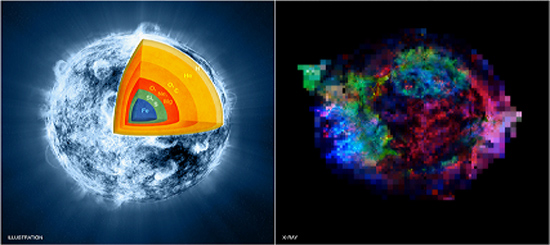
Evolution of an artist’s illustration into an inside-out star. Credit: Illustration: NASA/CXC/M.Weiss; X-ray: NASA/CXC/GSFC/U.Hwang & J.Laming
Sep 11, 2012
Is Cassiopeia A (Cas A) dying or just changing her fashion?
Bio 1:
In the beginning was an artist’s illustration of the consensus theory of stellar evolution. Thermonuclear fusion reactions at the center of the star transformed hydrogen into helium. After a time, the growing core of helium contracted enough under its own gravity to heat up to the stage where the helium transformed into oxygen and carbon. Successive contractions and transformations built up shells of neon, magnesium, silicon, and sulfur.
Finally, a core of iron began to grow. Iron is the dead-end of transformation succession: fusion reactions beyond iron absorb more energy than they release. The core can never balance it’s contracting with a new source of energy.
Three hundred years ago, the iron core of Cas A collapsed. The layers above imploded and blew themselves into space as a supernova.
R.I.P.
But now the autopsy reveals something surprising: the guts of the star—the iron and silicon and sulfur that should have been on the inside, that should have collapsed into a neutron star—are on the outside. The coroner reports, “Surprisingly, there is no evidence…for iron near the center…. Also, much of the silicon and sulfur, as well as the magnesium, is now found toward the outer edges…. [Something] somehow turned the star inside out.” He found in the outer layers “clumps of almost pure iron, [which] must have been produced by nuclear reactions near the center….”
Let’s examine this casual admission of surprise more closely. If the coroner was surprised, it must be because he was expecting something else. He was expecting something else because his theory predicted something else. Now a standard test procedure in science is to deduce some particular phenomenon from the theory to be tested and then to look for whether or not the phenomenon occurs. If it does, one proclaims that the theory has been validated (although this is a logically suspect exaggeration). If the phenomenon doesn’t occur…. Well, the matter is often simply hushed up. But logically the theory has been falsified, which means it’s not true, which means that only a fool would continue believing in it. Now, I don’t wish to cast aspersions on astronomers’ motley; I’ll just mention that they’re wearing it.
Furthermore, the coroner remarked that “[o]xygen, which according to theoretical models is the most abundant element in the remnant, is difficult to detect…because almost all the oxygen ions have had all their electrons stripped away.” It takes an astronomical amount of heat to smack oxygen atoms together hard enough to knock off all their electrons. The alleged explosion was long ago and far away. One might expect the debris to cool off a bit.
On the other hand (to foreshadow Bio 2), it takes only a modest amount of electricity to publicly embarrass an oxygen nucleus like that. A double layer capable of accelerating protons to cosmic-ray energies will strip electrons off oxygen atoms as easily as a bartender pops caps off beer bottles at happy hour.
Bio 2:
In the beginning was an analogy between the observed properties of plasma discharges in a lab and the observed characteristics of stars. A Bennett pinch in a galactic-scale Birkeland current squeezed the ambient plasma into a glowing balloon. High-energy discharges to the glowing skin generated light and x-rays, fused hydrogen into heavier elements, and sorted the elements into clumps and layers of like materials.
Three hundred years ago, an instability in the discharge current triggered a star-encompassing double layer to expand catastrophically. It carried not only the elements but also the processes that fused and sorted them into space.
Now, what’s on the outside of the nebula is merely a more distant version of what was originally on the outside of the star. The guts are still on the inside; we needn’t be nauseated or surprised; we still don’t know anything about them.
But we do know that the star is as much electrically alive as it always was; it just switched to a different mode of operation. Mourning is unnecessary.
The coroner would better spend his time on an autopsy of his theory than of his star.
Mel Acheson












